MS Dhoni’s ‘Dhoni Review System’ Steals the Show in CSK’s Match
MS Dhoni’s enduring legacy in Chennai cricket was once again on display during Chennai Super Kings’ match against Lucknow Super Giants. The iconic wicketkeeper-batsman’s presence at the MA Chidambaram Stadium ignited the city, with fans erupting in cheers as he took to the crease in the final over.
Dhoni’s impact extended beyond his batting performance, as he played a crucial role in a controversial umpiring decision. On the last ball of the 13th over, the umpire signaled a wide on a delivery to Marcus Stoinis. However, Dhoni, with his astute cricketing instincts, challenged the call through the Decision Review System (DRS).
To the delight of the crowd, Dhoni’s decision proved correct, and the wide call was reversed. The moment sparked a frenzy on social media, with fans coining the term “Dhoni Review System” to celebrate his uncanny ability to overturn umpiring decisions.
Despite his limited batting opportunities in recent years, Dhoni has consistently delivered impactful performances for CSK. In five IPL innings this season, he has scored 87 runs, remaining unbeaten each time. His strike rate of 255.88 and impressive record in the final over of innings have made him a formidable force.
Dhoni’s mastery of the death overs is evident in his career statistics. He has scored 772 runs in 313 balls in the 20th over, with a strike rate of over 246. This season, he has scored 57 off 16 balls in the final overs, with a strike rate of 356.25.
Among batters who have played at least 30 balls in overs 16-20 this tournament, Dhoni has the highest strike rate of almost 256 runs. Even young T20 specialists like Tristan Stubbs and Riyan Parag, as well as experienced finishers like Dinesh Karthik and Heinrich Klaasen, trail behind Dhoni.
Remarkably, Dhoni has achieved these impressive numbers while playing just 34 balls in this tournament, all during death overs. His boundary percentage of 87.30 per cent in overs 16-20 is also the highest, surpassing Dinesh Karthik and Andre Russell.
Dhoni’s presence in the CSK lineup continues to inspire fans and ignite the passion for cricket in Chennai. His ability to make a significant impact despite his limited playing time is a testament to his enduring greatness and the unwavering love and respect he commands from the city’s cricket enthusiasts.






